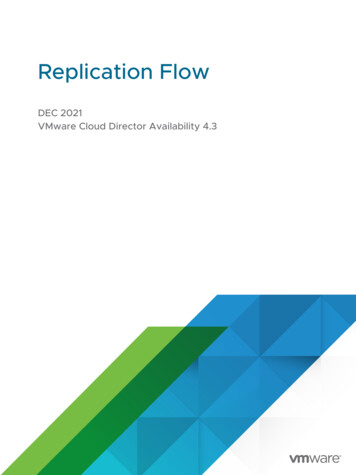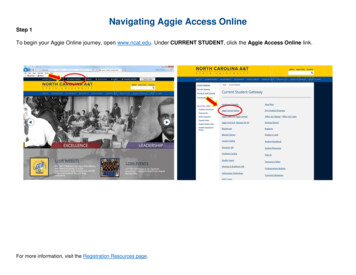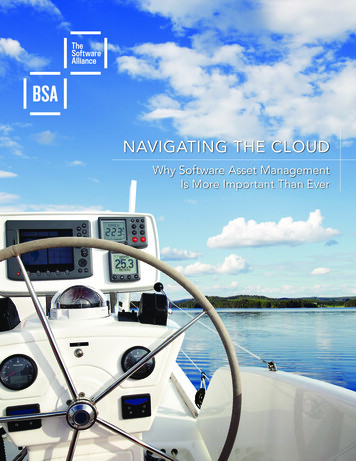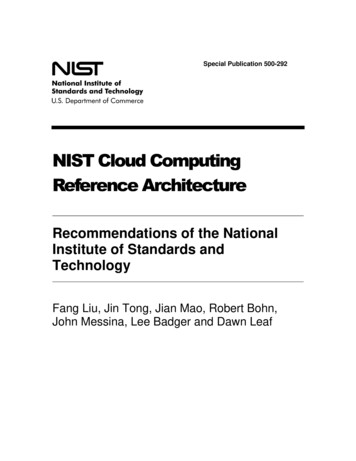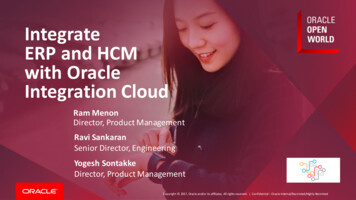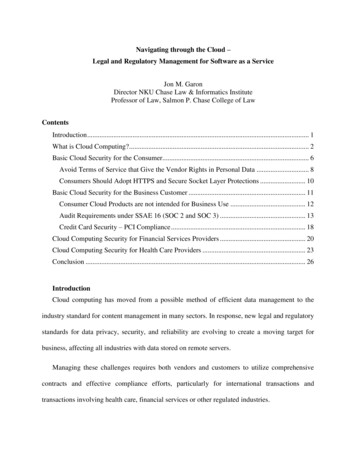
Transcription
Navigating through the Cloud –Legal and Regulatory Management for Software as a ServiceJon M. GaronDirector NKU Chase Law & Informatics InstituteProfessor of Law, Salmon P. Chase College of LawContentsIntroduction . 1What is Cloud Computing? . 2Basic Cloud Security for the Consumer. 6Avoid Terms of Service that Give the Vendor Rights in Personal Data . 8Consumers Should Adopt HTTPS and Secure Socket Layer Protections . 10Basic Cloud Security for the Business Customer . 11Consumer Cloud Products are not intended for Business Use . 12Audit Requirements under SSAE 16 (SOC 2 and SOC 3) . 13Credit Card Security – PCI Compliance . 18Cloud Computing Security for Financial Services Providers . 20Cloud Computing Security for Health Care Providers . 23Conclusion . 26IntroductionCloud computing has moved from a possible method of efficient data management to theindustry standard for content management in many sectors. In response, new legal and regulatorystandards for data privacy, security, and reliability are evolving to create a moving target forbusiness, affecting all industries with data stored on remote servers.Managing these challenges requires both vendors and customers to utilize comprehensivecontracts and effective compliance efforts, particularly for international transactions andtransactions involving health care, financial services or other regulated industries.
NAVIGATING THROUGH THE CLOUDJON M. GARON2This review will outline the practice of cloud computing and highlight the regulatoryframework under which companies can take advantage of its efficiencies. It will also exploresome of the contractual approach available to manage risk, achieve regulatory compliance, andbetter align the interests of the vendors and their customers.What is Cloud Computing?2011 will be known as the year of the tablet and of the cloud – and both trends are related.1“Cloud computing allows businesses and individuals to use the Internet to access softwareprograms, applications, and data from computer data centers . Cloud computing services arenot a unitary product but rather a continuum of services which businesses are able to access onan as-needed basis.”2 Among the services made available this year, Amazon, Google, Apple andMP3.com have all created cloud music storage services.3 While some of these music services areprovided in arrangement with the record labels, MP3.com has successfully demonstrated that thecloud storage falls within statutory protections for online providers.4In addition, services such as Dropbox, Box.net, Mozy, Spideroak, SugarSync, andFilesanywhere are a few of the services providing specialized document storage, but at theenterprise level, this field includes Google, AT&T, EMC, Amazon, IBM and other major1See, e.g., Lucas Mearian, Apple iPad, other tablets seen driving SaaS, cloud storage Lack of internal storage willpush users to online backup, synchronization services, COMPUTERWORLD, Apr. 12, 8/Apple iPad other tablets seen driving SaaS cloud storage;Jamie Slattery, What's the difference: iTunes Match vs Google Music Beta vs Amazon Cloud Player, KNOW YOURMOBILE, June 8, /whats the difference itunes match vs google music beta vsamazon cloud player.html.2Int‟l Bus. Machines Corp. v. Visentin, 31 I.E.R. Cas. (BNA) 1586 (S.D.N.Y. Feb. 16, 2011).3David Kravets, Judge OKs Unlicensed Cloud Music-Storage Service, WIRED, (Aug. 22, 2011, 6:51 nes-cloud-music-service/.4See Capitol Records, Inc. v. MP3tunes, LLC, 2011 U.S. Dist. LEXIS 93351 (S.D.N.Y. Aug. 22, 2011) (“In the fallof 2005, MP3tunes added a storage service allowing users to store music files in personal online storage "lockers."Songs uploaded to a user's locker could be played and downloaded through any internet-enabled device. MP3tunes' online storage system utilizes automatic and passive software to play back content stored at the directionof users. That is precisely the type of system routinely protected by the DMCA safe harbor.” At the same time,however, MP3.com was liable for 350 songs for which EMI had provided a take-down notice but the notice was notfollowed).
NAVIGATING THROUGH THE CLOUDJON M. GARON3providers. In some cases, these companies merely store files at a remote location; otherssynchronize the remotely stored data; while others provide software and full functionality fromthe remote locations to enable the user to have substantially unlimited access to both content andservice.In recent surveys, IT service provider CDW assessed the adoption of the cloud:CDW reported that 37 percent of health care companies maintain a writtenstrategy for cloud computing, which puts them in the middle range oforganizations that have taken this step. Of small businesses surveyed, 35 percenthave a written strategy for cloud adoption, compared with 59 percent of largebusinesses, 41 percent of federal agencies, 29 percent of state and localgovernments, 29 percent of higher education institutions and 31 percent of K-12schools.5If cloud computing seems rather vague and ill-defined, that is because it is.6 “[A]ll thisvagueness and variation arise from the fact that the whole thing began in fancy and in dreaming;and that there are no rules of architecture for a castle in the clouds.”7 NIST has attempted to addsome structural definitions upon which to begin placing the scaffolding of a common cloudnomenclature.8 “Cloud computing is a model for enabling convenient, on-demand networkaccess to a shared pool of configurable computing resources (e.g. networks, servers, storage,5Brian T. Horowitz, Health Care IT Industry Shies Away from Cloud Adoption: CDW, EWEEK.COM, May 27, CDW293373/.6See, e.g., Mathias Thurman, Security Manager's Journal: Giving cloud storage the ax, COMPUTERWORLD, June 6,2011, d Storage Gets the Ax?taxonomyId 17.7G.K. CHESTERTON, THE EVERLASTING MAN 64 (1925).8Peter Mell & Timothy Grance, The NIST Definition of Cloud Computing 2 (Nat‟l Inst. Stand. & Tech., NISTSpecial Publication 800-145 (Draft), Jan. 2011), available at raftSP-800-145 cloud-definition.pdf (“Cloud computing is a model for enabling ubiquitous, convenient, on-demandnetwork access to a shared pool of configurable computing resources (e.g., networks, servers, storage, applications,and services) that can be rapidly provisioned and released with minimal management effort or service providerinteraction.”).
NAVIGATING THROUGH THE CLOUDJON M. GARON4applications, and services) that can be rapidly provisioned and released with minimalmanagement effort or service provider interaction.”9The cloud services all incorporate the essential characteristics of (i) on-demand, self-serveaccess; (ii) broad network access that agnostically accepts all devices – including computers,laptops, smart phones, game consoles and other network-enabled devises; (iii) resource pooling;(iv) rapid elasticity or scalability; and (v) measured service optimization so that “usage can bemonitored, controlled, and reported, providing transparency for both the provider and consumerof the utilized service.”10Despite the complex definitions, the legal issues for the cloud are only new in degree, not intype. Companies have been using third parties for data warehousing, communications, andremote applications for years in all industries including the data-critical areas such as health careand financial services.11 The first iteration of this trend involved co-location agreements wherebythe company‟s data remained housed on separately maintained servers.12 Today, the informationis comingled in massive, distributed server farms along with potentially petabytes13 of data.NIST identifies four cloud deployment models:Private cloud. The cloud infrastructure is operated solely for an organization. It maybe managed by the organization or a third party and may exist on premise or offpremise.Community cloud. The cloud infrastructure is shared by several organizations andsupports a specific community that has shared concerns (e.g., mission, security9Id.Id.11E.g., 45 C.F.R. § 164.506(a) (2010) (limitations on health care data disclosure – “a covered entity may use ordisclose protected health information for treatment, payment, or health care operations”); 16 C.F.R. pt. 316 (2006)(security safeguard rules regarding financial data).12JACK W. PLUNKETT, PLUNKETT'S TELECOMMUNICATIONS INDUSTRY ALMANAC 2009 vi (Plunkett Research Ltd.2008).13Wikipedia.org, Petabyte, http://en.wikipedia.org/wiki/Petabyte (last visited Sept. 23, 2011) (A petabyte is equal insize to 1024 terabytes or one quadrillion bytes).10
NAVIGATING THROUGH THE CLOUDJON M. GARON5requirements, policy, and compliance considerations). It may be managed by theorganizations or a third party and may exist on premise or off premise.Public cloud. The cloud infrastructure is made available to the general public or alarge industry group and is owned by an organization selling cloud services.Hybrid cloud. The cloud infrastructure is a composition of two or more clouds(private, community, or public) that remain unique entities but are bound togetherby standardized or proprietary technology that enables data and applicationportability (e.g., cloud bursting for load balancing between clouds).14The private cloud essentially describes the existing vendor relationship between companiesand their third party vendors. One of the leading data firms, Iron Mountain, stores “over 3petabytes of PC data for some 3 million users in its secure offsite facilities worldwide.”15 Thoughit now describes its service as a cloud solution, Iron Mountain, like other secure data storagevendors, has been providing secure digital data storage since the mid-1990s in physically securefacilities utilizing sophisticated data encryption and physical security to restrict access to dataservers.16Companies may be moving business applications to cloud services, 17 storing sensitive datawith third-party vendors, or relying on business partners which are utilizing such services.1814Mell & Grance, supra note 8.Cloud Based Data Protection, nnected security brief.pdf(last visited Sept. 22, 2001).16Id.17Mell & Grance, supra note 8. Known as Cloud Software as a Service (“SaaS”), it is distinct from backup andstorage services because all computing takes place on the vendor‟s equipment and significantly increases third partyaccess to content.18See American Institute of CPAs, Users and User y companies function more efficiently and profitably by outsourcing tasks or entire functionsto service organizations that have the personnel, expertise, equipment, or technology toaccomplish these tasks or functions. Examples of such services include cloud computing, managedsecurity, health care claims management and processing, sales force automation etc. Although usermanagement can delegate these tasks or functions to a service organization, they are usually heldresponsible by those charged with governance (for example, the board of directors), customers,shareholders, regulators and other affected parties for establishing effective controls over thoseoutsourced functions.Id.15
NAVIGATING THROUGH THE CLOUDJON M. GARON6The core problem of cloud computing lies in guaranteeing the integrity andconfidentiality of the cloud user’s data processing, and this is true not only forpersonal data, but for any data that require confidentiality and integrity, such asbusiness and trade secrets, research data, and any other data protected underintellectual property law. The goal is to prevent harmful, unauthorized access bythird parties.19The public cloud and hybrid cloud raise additional risks that business needs to manage.Unlike the direct one-to-one relationship between a business and private cloud vendor, a publiccloud provider has a one-to-many relationship with every individual and entity using the cloudservice. As a result, the contract is essentially a take-it-or-leave-it click-wrap agreement whichmay eviscerate legal protections for the customer of the cloud service.Basic Cloud Security for the ConsumerAt a minimum, cloud computing is really providing “software as a service” (SaaS), meaning“the consumer is to use the provider‟s applications running on a cloud infrastructure. Theapplications are accessible from various client devices through a thin client interface such as aweb browser (e.g., web-based email).”20 More robust models can also include the cloud platformor the cloud infrastructure as a service.21Many consumer services are part of the public cloud. In addressing public cloud concerns,there are issues involving the contractual rights of the consumers as well as the ability of theconsumer to address problems of data privacy and integrity. For example, the Sony Playstation19THILO WEICHERT, CLOUD COMPUTING & DATA PRIVACY, SEDONA CONF. WORKING GROUP SERIES 3, FEB. 2011(translated into English by Lillian Clementi).20CLOUD SECURITY ALLIANCE, SECURITY GUIDANCE FOR CRITICAL AREAS OF FOCUS IN CLOUD COMPUTING 15-16(Dec. 2009), https://cloudsecurityalliance.org/csaguide.pdf (“The consumer does not manage or control theunderlying cloud infrastructure including network, servers, operating systems, storage, or even individualapplication capabilities, with the possible exception of limited user-specific application configuration settings.”(quoting Mell & Grance, supra note 8, at 2)).21Id. at 15-16.
NAVIGATING THROUGH THE CLOUDJON M. GARON7network, Google Gmail system, and many other high-profile targets have been compromised.22Non-private clouds have more users and therefore more opportunities for vulnerabilities. Theyare also simply larger targets. Public cloud services may also fail to provide the level of dataprivacy and security necessary to protect the data or to assure the legal protections ofconfidentiality and trade secrets are met.Private cloud configurations are not substantially different from the preexisting off-siteservice and storage relationships clients had with their vendors. But for non-private cloudcomputing, the key is scalability, which means that the infrastructure is built to accommodatelarge numbers of similarly situated customers who all have their data and services shared acrossapplications and servers.Although not an essential characteristic of Cloud Computing in NIST‟smodel, CSA has identified multi-tenancy as an important element of cloud. Multitenancy in cloud service models implies a need for policy-driven enforcement,segmentation, isolation, governance, service levels, and chargeback/billingmodels for different consumer constituencies. Consumers might utilize a publiccloud provider‟s service offerings or actually be from the same organization, suchas different business units rather than distinct organizational entities, but wouldstill share infrastructure.23As a result of the multi-tenancy – or resource sharing – that occurs among the users of acloud service, the individual customers have far less leverage or control in negotiating the datasecurity and privacy provisions of the service agreement.From the consumer‟s perspective, the risks associated with utilization of a cloud storage orSaaS provider can be analyzed through its atha Bray, Hackers and thieves a growing Web menace; Technology lag leaves systems vulnerable, BOSTONGLOBE, June 11, 2011, at 1; Hackers breach Citibank accounts 200K e-mail addresses, other information stolen,STAR-LEDGER, June 10, 2011, at 19.23CLOUD SECURITY ALLIANCE, supra note 20, at 16.
NAVIGATING THROUGH THE CLOUDJON M. GARON8agreement and its operational steps to meet the obligations set forth in those consumeragreements.Avoid Terms of Service that Give the Vendor Rights in Personal DataSome services, such as Google‟s Gmail and Google Docs disclose in the terms of service thatGoogle has access to the content of the documents.24 The agreement is explicit in stating thatGoogle has a non-exclusive license to exploit all the content provided by the users of theseservices. As a legal matter, Google has fulfilled its duty, though it would not be a surprise to findthat millions of users have not read these provisions and may not realize the disclosure beingcreated.A more interesting example comes from Dropbox. Used by 25 million people, Dropboxprovides an effective combination of synchronizing computers and storing documentsremotely.25 Dropbox became notorious for allegedly overstating the security it provides for its24Google Terms of Service, http://www.google.com/accounts/TOS?hl en (last visited Sept. 18, 2011).11. Content license from you11.1You retain copyright and any other rights you already hold in Content which you submit,post or display on or through, the Services. By submitting, posting or displaying the content yougive Google a perpetual, irrevocable, worldwide, royalty-free, and non-exclusive license toreproduce, adapt, modify, translate, publish, publicly perform, publicly display and distribute anyContent which you submit, post or display on or through, the Services. This license is for the solepurpose of enabling Google to display, distribute and promote the Services and may be revokedfor certain Services as defined in the Additional Terms of those Services.11.2You agree that this license includes a right for Google to make such Content available toother companies, organizations or individuals with whom Google has relationships for theprovision of syndicated services, and to use such Content in connection with the provision of thoseservices.11.3You understand that Google, in performing the required technical steps to provide theServices to our users, may (a) transmit or distribute your Content over various public networksand in various media; and (b) make such changes to your Content as are necessary to conform andadapt that Content to the technical requirements of connecting networks, devices, services ormedia. You agree that this license shall permit Google to take these actions.11.4You confirm and warrant to Google that you have all the rights, power and authoritynecessary to grant the above license.Id.25I am a customer of Dropbox (using its free account). As I will discuss, however, I do not use it for either clientinformation or student information covered by FERPA for the reasons discussed below.
NAVIGATING THROUGH THE CLOUDJON M. GARON9customer.26 Dropbox does not claim any right to a non-exclusive license of customer files or therights to transfer information regarding the files to third parties.27At the same time, however,Dropbox has a rather broad exception allowing it to have use of its customers‟ files that goesbeyond compliance with laws or court orders to include personal safety and to “prevent fraud orabuse of Dropbox or its users” and “Dropbox‟s property rights.”28 This also discloses that theencryption utilized by Dropbox does not protect from Dropbox employees.29 As a result of thepublic discussion of Dropbox‟s limitations and a FTC action brought by a cybersecurity expert,Dropbox has updated its terms and disclosure to make its policies more accurate. 30 Third partyadd-ons can also provide client-side encryption to further protect the data (which is a good idea26See G.F., Internet security - Keys to the cloud castle, THE ECONOMIST (May 18, 05/internet security.27Dropbox Terms of Service, http://www.dropbox.com/terms (last visited Sept. 23, 2011).You retain full ownership to your stuff. We don‟t claim any ownership to any of it. These Termsdo not grant us any rights to your stuff or intellectual property except for the limited rights that areneeded to run the Services, as explained below.We may need your permission to do things you ask us to do with your stuff, for example,hosting your files, or sharing them at your direction. This includes product features visible to you,for example, image thumbnails or document previews. It also includes design choices we make totechnically administer our Services, for example, how we redundantly backup data to keep it safe.You give us the permissions we need to do those things solely to provide the Services. Thispermission also extends to trusted third parties we work with to provide the Services, for exampleAmazon, which provides our storage space (again, only to provide the Services).To be clear, aside from the rare exceptions we identify in our Privacy Policy, no matterhow the Services change, we won‟t share your content with others, including law enforcement, forany purpose unless you direct us to. How we collect and use your information generally is alsoexplained in our Privacy Policy.Id.28Dropbox Privacy Policy, http://www.dropbox.com/terms#privacy (last visited Sept. 23, 2011).Compliance with Laws and Law Enforcement Requests; Protection of Dropbox's Rights. We maydisclose to parties outside Dropbox files stored in your Dropbox and information about you thatwe collect when we have a good faith belief that disclosure is reasonably necessary to (a) complywith a law, regulation or compulsory legal request; (b) protect the safety of any person from deathor serious bodily injury; (c) prevent fraud or abuse of Dropbox or its users; or (d) to protectDropbox‟s property rights. If we provide your Dropbox files to a law enforcement agency as setforth above, we will remove Dropbox‟s encryption from the files before providing them to lawenforcement. However, Dropbox will not be able to decrypt any files that you encrypted prior tostoring them on Dropbox.Id.29See G.F., supra note 26.30See id. (describing complaint by Chris Soghoian, filed May 11, 2011,http://www.wired.com/images nal.pdf).
NAVIGATING THROUGH THE CLOUDJON M. GARON10anyway, if one carries sensitive data on a laptop or other device). 31 Spideroak, a directcompetitor to Dropbox emphasizes its encryption system that places the encryption key on theuser‟s computer – meaning that it cannot decrypt and disclose the files on its servers. 32 Thesecurity model, however, means that Spideroak is incapable of any password retrieval, so if theusername or password is lost, or an executor of a decedent‟s estate needs access, the content isforever lost. Given the risk of permanent loss, many consumers may be making a very rationalechoice to risk the theoretical concern about Dropbox disclosure, and this may well suffice unlessthere is a legal obligation to treat the information more securely.Consumers Should Adopt HTTPS and Secure Socket Layer ProtectionsBeyond storage and file synchronization, the consumer minimum can be found in theadditional protection afforded by the encrypted “Hypertext Transfer Protocol Secure (“https”)system. “Using an encryption algorithm, the “https:” tool gives users a mostly private channel tosurf the web and share private information.”33Any sensitive data, including online banking,healthcare or other information a person considers sensitive should be sent only using thisprotocol. More and more vendors are utilizing the https as their default standard.At the same time, however, nothing is wholly secure. A Farsi-speaking hacker recentlybreached a Dutch certificate authority, DigiNotar, and used DigiNotar‟s legitimate certifyingauthority to issue false SSL Certificates – the tools used to assure that your data is traveling tothe entity one believes is on the other side of the transaction.34 With false Secure Socket Layer31Simon Mackie, SecretSync Adds Client-Side Encryption to Dropbox on the Fly, WEBWORKERDAILY, (May 17,2011), eroak, https://spideroak.com/ (last visited Sept. 23, 2001). See also G.F., supra note 26 (discussing thedifferences in approach).33Security in 60 Seconds - How to Fight Back Against Hackers and Protect Yourself on the Web, VOICE OFAMERICA, (Aug. 22, 2011), /22/security-in-60-seconds/.34Steven J. Vaughan-Nichols, Fake SSL certificates pirate Web sites, ZD NET (Sept. 6, 2011, 3:21 certificates-pirate-web-sites/1428.
NAVIGATING THROUGH THE CLOUDJON M. GARON11(“SSL”) certificates, the hackers could intercept data mid-transfer to monitor or re-use thatinformation. This is evidently the first breach of the SSL certificates and Microsoft, Apple andthe browser providers have moved quickly to block the DigiNotar certificates. But it serves as areminder that all security is based on industry precautions, best efforts and ongoing vigilance. Nosystem will be impenetrable. A good system will be responsive to threats and be continuallyupdated; it cannot promise absolute security.Basic Cloud Security for the Business CustomerFor a corporate account, minimum precautions are required, regardless of the industry. Forexample, relying on the terms of service of Google could be a substantial problem. Evencompanies operating in unregulated industries must comply with their own stated privacy andsecurity policies.35 Unless those policies state that the company shares all data with the world, orthe policy specifically includes Google‟s non-exclusive license, the use of these consumer toolsfor business could (and should) give rise to liability.36 The vast majority of jurisdictions alsohave data security breach notification laws, so a poorly selected vendor can open a company toembarrassment and even liability if its vendor is itself out of compliance in the event of abreach.3735Section 5 of the FTC Act, IT LAW WIKI, http://itlaw.wikia.com/wiki/Section 5 of the FTC Act (last visited Sept.18, 2011) (“The FTC has taken action against websites for violating their own privacy policies as a deceptive tradepractice.”); Customer Information And Privacy, Safeselling.org, http://www.safeselling.org/privacy.shtml#2 (lastvisited Sept. 25, 2011) (“Using its authority under Section 5 of the FTC Act, which prohibits unfair or deceptivepractices, the Commission enforces the promises in privacy statements, including promises about the security ofconsumers‟ personal information.”).36Google uses a different license for its corporate and educational clients. See, e.g., Google Apps forBusiness Online Agreement, http://www.google.com/apps/intl/en/terms/premier terms.html (last visited Sept. 23,2011) (“7.1 Intellectual Property Rights. Except as expressly set forth herein, this Agreement does not grant eitherparty any rights, implied or otherwise, to the other‟s content or any of the other‟s intellectual property. As betweenthe parties, Customer owns all Intellectual Property Rights in Customer Data, and Google owns all IntellectualProperty Rights in the Services.”).37See Nat. Conf. of State Legislatures, State Security Breach Notification Laws,http://www.ncsl.org/default.aspx?tabid 13489 (last visited Sept. 23, 2011) (“Forty-six states, the District of
NAVIGATING THROUGH THE CLOUDJON M. GARON12Consumer Cloud Products are not intended for Business UseA second concern for the general business is the ownership of content, with widely adoptedservices like the public services of Google transferring a non-exclusive copyright license to theadvertising and search giant.38 Facebook also extracts such a non-exclusive license.39 Theselicenses may not be consistent with the licenses under which a company acquired rights to stockphotographs, artwork or other intellectual property it exploits.Use of social media may be essential for business marketing and customer relations, but thecontent posted on those sites should be carefully cleared to be sure the company has the rights todistribute in that media. Similarly, the enforcement of intellectual property rights in social mediais often challenging, so companies should think carefully regarding the value of the assets theydistribute. Companies need to balance the value of the social media interaction with the value ofthe copyrighted work to assess the risks of rampant public copying. If the unauthorizedredistribution does only modest harm (or serves as viral marketing), then there is little risk; if thework would otherwise sell for a very high value in other distribution channels, then trying tomaintain control of that work on social media may not make strategic sense.Columbia, Puerto Rico and the Virgin Islands have enacted legislation requiring notification of security breachesinvolving personal information.”).38E.g., Google Terms of Service, http://www.google.com/apps/intl/en/terms/user terms.html (last visited Sept.23,2011). See Jon M. Garon, Searching Inside Google: Cases, Controversies and the Future of the World’s MostProvocative Company, 30 LOYOLA OF L.A. L. REV
is comingled in massive, distributed server farms along with potentially petabytes13 of data. NIST identifies four cloud deployment models: Private cloud. The cloud infrastructure is operated solely for an organization. It may be managed by the organization or a third party and may exist on premise or off premise. Community cloud. The cloud .





